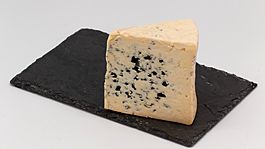Bleu des Causses facts for kids
Quick facts for kids Bleu des Causses |
|
|---|---|
 Bleu des Causses  Texture of Bleu des Causses |
|
| Country of origin | France |
| Region, town | At the entrance of Gorges du Tarn |
| Source of milk | Cows |
| Pasteurised | No |
| Fat content | 45% |
| Aging time | 3-6 months |
| Certification | AOC, 1949 |
Template:TOC limit=3
Bleu des Causses is a yummy French blue cheese. It's made from whole cow's milk. Some people think it's like a milder version of Roquefort.
This cheese has 45% fat. It ages for 3 to 6 months. It rests in cool, natural caves in the Gorges du Tarn area. These special caves help the cheese get its unique smell and taste. They keep the temperature just right. Today, it's a bit rare. Only a few small farms still make it.
Contents
History of Bleu des Causses
Bleu des Causses has a long history. It's similar to Roquefort cheese. Long ago, cheesemakers used milk from cows, sheep, or both. It depended on the season.
Ancient Times
Pliny the Elder, a Roman writer, talked about cheeses from the Mont Lozère and Gévaudan areas. People often think he was writing about an early blue cheese from this region. However, he didn't clearly say they were blue.
Middle Ages Cheese Stories
There's a fun story about Charlemagne and cheese. It's often said he ate blue cheese. But the story actually shows him cutting off the crust. This is like how you'd eat a white cheese, not a blue one.
The story goes that Charlemagne was offered some rich, creamy cheese. He cut off the crust because he thought it didn't taste good. The bishop serving him said, "Lord emperor, you're throwing away the best part!" Charlemagne tried the crust. He slowly ate it and liked it.
Modern Cheese Making
For a long time, many small cheesemakers made cheese from cow's milk, sheep's milk, or a mix. These cheeses didn't have a special name.
In 1925, the famous Roquefort cheese got its official name. It had to be made in Roquefort-sur-Soulzon. Also, only sheep's milk could be used. This meant cow's milk cheeses were not allowed to be called Roquefort.
So, cow's milk cheese makers started their own groups. They created a brand called "Valmont." This helped sell their "bleu de l'Aveyron" cheese. The name "Bleu des Causses" became official in 1941 and 1946.
In 1949, Bleu des Causses received its official Appellation d'origine contrôlée (AOC) status. This means it has a protected name and must follow strict rules. In 1992, cow farmers joined the union that makes this cheese.
Where Bleu des Causses is Made
The area where Bleu des Causses milk is produced and the cheese is made is quite large. It includes valleys, limestone, and some mountain areas. This region covers parts of the Lot, Aveyron, and Lozère departments in France.
Special Cheese-Making Zones
The main refining areas are more specific. They are in certain parts of the Millau district. These include towns like Campagnac and Saint-Affrique. Also, the towns of Trèves and Pégairolles-de-l'Escalette are included.
Geology and Climate
The land where the cows graze is called "caussenardes." This is where the cheese gets its name. The ground is mostly limestone. This means water drains away quickly. So, the land can be dry if it doesn't rain much.
The plants that grow here are short and bushy. But they are very flavorful. This special vegetation helps give the cow's milk its unique taste.
The cheese is aged in natural caves. These caves are found in limestone cliffs. Rivers like the Tarn have carved these cliffs over many years. Rockslides created cracks in the rock called "fleurines." These cracks let air move through the caves.
The caves have a very steady temperature and humidity. This is perfect for the blue mold to grow. This mold gives the cheese its special blue veins.
How Bleu des Causses is Made
The process of making Bleu des Causses is very specific.
Milk Production
The milk used must be whole cow's milk. The cows must be healthy and free of certain diseases. There are no special rules about what the cows eat.
Making and Aging the Cheese
First, the cow's milk is warmed to about 30-33°C (86-91°F). At the same time, special spores of a mushroom called Penicillium roqueforti are added. This is the mold that creates the blue veins in the cheese. These spores come from special types found in the aging area.
Next, a substance called rennet is added. This makes the milk curdle, turning it into a solid mass called curd. The curd is then cut into small pieces. It is stirred to release the liquid part, called whey.
The cheese curds are then put into molds with holes. The cheese is turned over to help more whey drain out. After taking the cheese out of the molds, it is salted with dry salt. It is not soaked in salty water.
After this, the cheeses are sent to special aging cellars. When they arrive, they are brushed or washed. Then, they are poked with needles. This creates small holes inside the cheese. These holes help air get in. This allows the blue mold to grow well throughout the cheese.
The cheeses are then placed on racks in the caves. These caves have natural air circulation from the "fleurines." The cheese must age for at least 70 days. This time is needed for the cheese to develop its full flavor. The cheese is not refrigerated during this aging process.
Images for kids
See also
In Spanish: Bleu des Causses (queso) para niños




